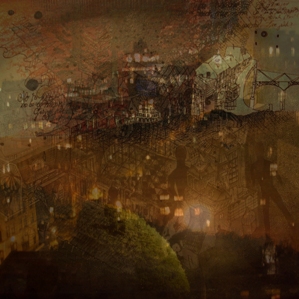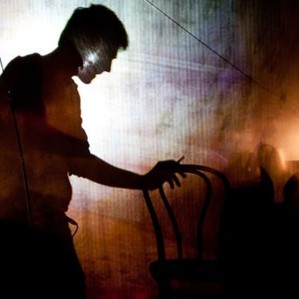This theatre experiment goes on from 6am to 6am, non-stop for 24 hours, telling twenty-four different life stories suspended in time in one slow-paced, lazy day. Improvised sounds, images, and words reiterate with no hope for change. But then again, why not try… ?
Much of the 24 hours are filled with acappella music, allowing the viewer to drift away from what appears, and distracting him from the passing of time. 24h is a theatrical experiment, an extention of time, interrupted with sound, improvisation, images, live painting, and words. The show runs from 6:00am to 6:00am non-stop, twice a week, with the original script, music, and performance by the young Wacław Miklaszewski.
“Summerhall has been serving up a remarkable slice of Polish avant-garde theatre this Fringe. Many of these shows have been characterised by a complexity of set design, and a level of polish (pardoning the unfortunate pun), that wouldn’t look out of in the grander setting of this August’s Edinburgh International Festival. But watching ’24h’, Waclaw Mikłaszewski’s one-man 24-hour-long perspex-encased epic, it isn’t hard to recognise the vast and rugged heart of Fringe theatre beating beneath the show’s visually stunning surface. 24h is a risk taken and grasped in both hands – a wild, provocative and utterly spellbinding performance by a true experimenter. Mikłaszewski’s genius is manifest, even when its expression is difficult to digest or even endure.I sat through all of it, and so (with some absences) did two others. Meanwhile, with perhaps the record number of late entrants and walk-outs for any Fringe show, a large floating audience came and went. Their comings and goings created a tidal atmosphere in the space surrounding the one-door room’s central transparent box, inside which Mikłaszewski was making all the weather. He controlled lighting and mic effects, and positioned props including a small globe which, lit by a single light, mirrored the projected videos of the Earth from space that scattered around the four walls of the outside room. This beautiful sequence was on a shortish loop, as was a subtle soundtrack of muffled noises of everyday life: footsteps, doors, a baby crying. Meanwhile a clock ticked noisily.The show is 24 hours long. So what does he do in all that time? For some of it, he tells a story, through a cast of 24 characters living in the same apartment building (presumably as functional and cuboid as the performance box itself). The characters interacted heavily with the audience, forcing viewers to become actors themselves. His ability to improvise so effortlessly in a foreign language was impressive, but more impressive was the way he used the possibility of a language-barrier as a crucial aspect of the production; one of the most interesting distinctions between the characters was their varying grasp of English. Though there was progression in their narrative strands, often revealed second hand by another character, these characters live lives in stasis. They might have been waiting for someone or something, or have found themselves with a day off and nothing to do. Slowly one got a sense of the weight and depth of a single day, its texture and its mass.All the time the miniature globe was lit up and the world on the projection went on spinning. We are used to seeing similar footage accompanied by a soaring soundtrack, as a way of encouraging us to think of the insignificance of human life when viewed from a grand cosmic scale. But accompanied only by Miklaszewski’s distorted vocals the contours of the blue planet seemed dreary and repetitive, stretching on and on like each endless day off work. Mikłaszewski’s vocalisations – his highly accomplished scat singing, and long droning sections of beatboxing – set the tone between the acted scenes, often throwing up occasional words and phrases from the random and mundane to the pertinent, drawing on ideas raised by the acted segments. Sometimes these intermissions lasted ten minutes, sometimes two or three hours. The hypnotic effect of these segments is almost impossible to describe.Inevitably, the bodily needs of audience and performer – the need for sleep, and for food – are put under the spotlight. I regretted choosing soup for lunch. Miklaszewski actively encourages audience members to fall asleep in certain segments of the show, and his singing – distorted as if coming from several miles underwater – is indeed soporific. A real sense of solidarity develops between audience and performer – by joining Miklaszewski’s vigil, the audience become a central part of the performance. One expression of this solidarity took the form of an exchange of food, Miklaszewski kindly handing out chocolate to the audience. At first the proffered gifts from his impossibly small provisions box seemed to hint at a cosmic theme: a packet of Milky Way Magic Stars, a few pieces of Galaxy. But characteristically he refused to be pinned down to a simple formula, with half a Snickers at 11:25pm scuppering my theory for good. By the early hours of the morning, the tendency to start coming up with theories and interpretations of this work is almost irresistible, especially if the analysis is chocolate-based.As I constructed a fort out of chairs and clothing and settled down to sleep out the last hour or so, I realised that on this, perhaps the first day in my life spent almost entirely in one room, I was more conscious than ever of the vast distance covered in that time by the spot I occupied on the Earth. Remaining motionless while watching the Earth move is perhaps the best reminder that sometimes the most static experiences are the most moving. I cannot speculate as to the reasons for the show’s lack of publicity, nor can I be sure of what sort of audience the company hoped for. With all its play on audience interaction, it would be impossible to label this production as indifferent to its viewers. I can only encourage you, in the unlikely event that you are reading this before the second Edinburgh showing, to see it, and come for the day if you can.”



